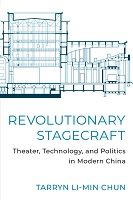Revolutionary Stagecraft
External Review of Whole Manuscript
Theater, Technology, and Politics in Modern China
| dc.contributor.author | Chun, Tarryn | |
| dc.date.accessioned | 2024-04-22T12:17:44Z | |
| dc.date.available | 2024-04-22T12:17:44Z | |
| dc.date.issued | 2024 | |
| dc.identifier.uri | https://library.oapen.org/handle/20.500.12657/90008 | |
| dc.description.abstract | Revolutionary Stagecraft draws on a rich corpus of literary, historical, and technical materials to reveal a deep entanglement among technological modernization, political agendas, and the performing arts in modern China. This unique approach to Chinese theater history combines a close look at plays themselves, performance practices, technical theater details, and behind-the-scenes debates over “how to” make theater amid the political upheavals of China’s 20th century. The book begins at a pivotal moment in the 1920s—when Chinese theater artists began to import, use, and write about modern stage equipment—and ends in the 1980s when China's scientific and technological boom began. By examining iconic plays and performances from the perspective of the stage technologies involved, Tarryn Li-Min Chun provides a fresh perspective on their composition and staging. The chapters include stories on the challenges of creating imitation neon, rigging up a makeshift revolving stage, and representing a nuclear bomb detonating onstage. In thinking about theater through technicity, the author mines well-studied materials such as dramatic texts and performance reviews for hidden technical details and brings to light a number of previously untapped sources such as technical journals and manuals; set design renderings, lighting plots, and prop schematics; and stage technology how-to guides for amateur thespians. This approach focuses on material stage technologies, situating these objects equally in relation to their technical potential, their human use, and the social, political, economic, and cultural forces that influence them. In each of its case studies, Revolutionary Stagecraft reveals the complex and at times surprising ways in which Chinese theater artists and technicians of the 20th century envisioned and enacted their own revolutions through the materiality of the theater apparatus. | en_US |
| dc.language | English | en_US |
| dc.subject.classification | thema EDItEUR::A The Arts::AT Performing arts | en_US |
| dc.subject.classification | thema EDItEUR::A The Arts::AT Performing arts::ATJ Television | en_US |
| dc.subject.classification | thema EDItEUR::A The Arts::AT Performing arts::ATD Theatre studies::ATDH Theatre: technical and background skills | en_US |
| dc.subject.classification | thema EDItEUR::N History and Archaeology::NH History::NHF Asian history | en_US |
| dc.subject.other | Chinese theater, Chinese drama, theater history, stage technology, technology, theater design, technical theater, lighting, scenography, special effects, theater architecture, stage equipment, technics, revolution, politics, revolutionary politics, modern China, huaju, spoken drama, yangbanxi, model operas, propaganda, Chinese literature, Chinese culture, Nuhou ba, Zhongguo!, Roar, China!, Leiyu, Thunderstorm, Shisanling shuiku changxiangqu, Fantasia of the Ming Tombs Reservoir, Nihongdeng xia de shaobing, Sentinels Under the Neon Lights, Dongfanghong, The East is Red, Hongdeng ji, The Red Lantern, Jialilüe zhuan, Life of Galileo | en_US |
| dc.title | Revolutionary Stagecraft | en_US |
| dc.title.alternative | Theater, Technology, and Politics in Modern China | en_US |
| dc.type | book | |
| oapen.identifier.doi | 10.3998/mpub.11555896 | en_US |
| oapen.relation.isPublishedBy | e07ce9b5-7a46-4096-8f0c-bc1920e3d889 | en_US |
| oapen.relation.isbn | 9780472076567 | en_US |
| oapen.relation.isbn | 9780472056569 | en_US |
| oapen.pages | 339 | en_US |
| peerreview.anonymity | Double-anonymised | |
| peerreview.id | d98bf225-990a-4ac4-acf4-fd7bf0dfb00c | |
| peerreview.open.review | No | |
| peerreview.publish.responsibility | Scientific or Editorial Board | |
| peerreview.review.decision | Yes | |
| peerreview.review.stage | Pre-publication | |
| peerreview.review.type | Full text | |
| peerreview.reviewer.type | External peer reviewer | |
| peerreview.title | External Review of Whole Manuscript | |
| oapen.review.comments | The proposal was selected by the acquisitions editor who invited a full manuscript. The full manuscript was reviewed by two external readers using a double-blind process. Based on the acquisitions editor recommendation, the external reviews, and their own analysis, the Executive Committee (Editorial Board) of U-M Press approved the project for publication. |

